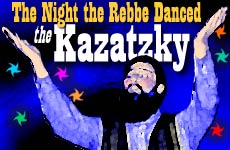 Vampire Weekend's Surprising Jewish Stories
Vampire Weekend's Surprising Jewish Stories


5 min read
Who could do the kazatzky like Mendel? No one, including the Cossacks who guarded the Czar himself.
My Zayde was a storyteller, especially on Chanukah. High on the list of "Zayde's Ten Biggest Hits" was The Tzadik of Zomzach. "Tell us the story of the Tzadik," we grandchildren chorused.
He couldn't resist. Although the tale had many variations, it always began the same: "Once there was a peasant and a Rebbe in the village of Zomzach. The peasant was only a peasant and I'll tell you about him later, but the Rebbe -- he was the Tzadik of Zomzach. That's what they called him. Visitors, petitioners, followers from the entire district paraded through his court. Infertility? Halachic questions? No job? A sour stomach? An unmarried daughter? Go tell it to the Sage of Zomzach. We Jews, you know, don't really need an intermediary. But if your Malka was unmarried, thirty-nine, and had a small wart on her forehead, why not let the Rebbe offer a short prayer so Zalman, the tailor, might suddenly be captivated by small warts. It couldn't hurt.
Now in this same village of Zomzach, that was glorified by the presence of the Rebbe and Zalman the tailor, lived Mendel the peasant, his wife, and a seven-year-old daughter. As poor and hungry they were as the crows who pecked in the winter fields of dried corn stalks. Their total possessions would have fit on a one-horse wagon. They were drowned in poverty because Mendel, believe it or not, was a kazatzky dancer. That's what he did. He had a nature, shall we say, like the butterfly, not the industrious honeybee. For weddings, bar mitzvahs, birthdays, anniversary parties, he danced the Cossack kazatzky. His pay was a sack of flour, maybe a chicken, a handful of copper coins.
And as though their life wasn't bleak enough, their only child -- the seven-year-old Miriam, a beautiful child with vivid red hair -- was bedridden. She hadn't walked since her 5th birthday. And it was this misfortune that provoked the strange, unexplained, events at Zomzach.
"But why am I telling you this?" suddenly blurted out Zayde. "You've heard it a dozen times. You know what happened." He turned away to light his pipe.
He knew we would plead. And we knew because he loved to tell the story that he would continue.
"So, on Chanukah," he went on, "the wife said to Mendel, ‘Go to the Rebbe -- ask for a blessing for Miriam. It's Chanukah, the Rabbi won't deny you. It couldn't hurt, you know. And God knows we can't send for the doctor in Cracow'.
‘But I have no gift,' said the kazatzky dancer. ‘And you know everyone who asks the Tzadik of Zomzach for a prayer on Chanukah brings something. A token that the Rebbe gives to his students.'
‘Go!' said the wife. ‘Pick some flowers from the fields. Find a colored stone. Anything. Just go!'
Soon, there he was at the Holy man's holiday court shouldering his way through a crowd of admirers and petitioners. He stood in front of the Tzadik of Zomzach - who listened attentively to his plea: that he should pray for the sick child who hadn't walked in many months.
Here, Zayde paused. "You know what happened. Why should I continue? Let me drink my tea." But a roar of protest from us kids reinspired the storyteller.
So he continued, "As Mendel humbly stood at the Rebbe's table, he thought, I have no gifts; but nobody, nothing, including a whirling Chanukah dreidle, can spin like me. I'll bet the Rebbe would enjoy my Cossack kazatzky -- the one where I hop on one foot, kick straight out with the other with my arms folded tightly across my chest.
And that's what he did. And the onlookers picked up the beat of his flying feet. They clapped, they roared with approval. Who could do the kazatzky like Mendel? No one, including the Cossacks who guarded the Czar himself.
The Rabbi clapped, too. As he clapped he looked heavenward and his lips moved as though in prayer. And before you could say "Judah Maccabee" the Alte Rebbe had leaped the table, joined hands with the peasant and whirled around the room with him. "God wants the heart," he cried over and over.
The spectators grinned and clapped and whistled with delight. Ah, that was their Rebbe. And what a heart he had. But soon their smiles turned to astonishment. THERE WERE THREE FIGURES in the circle. And one of them was a small red-haired girl!
We listeners screamed, "Zayde, Zayde, tell us how she danced".
"How she danced? How do you think she danced? She had the kazatzky gene in her blood."
She was magnificent. Naturally quicker than the Alte Rebbe, she kept up with her father. But when the dance was completed, only the Tzadik of Zomzach and Mendel the Peasant was seen.
And when the peasant arrived home, Miriam standing erect beside her mother, met him at the door. She smiled at her father. Then quickly, she dropped into the traditional kazatzky position. Three quick spins brought joy to his heart. They hugged."
"It's not true," said my older brother. "It's what they call a ‘Zaydemeiser' in Yiddish. Or a ‘Tall Tale' in English."
"All I know," said my grandfather, "is that MY Zayde, who was there the night the Rebbe did the kazatzky, told me the story every Chanukah."
